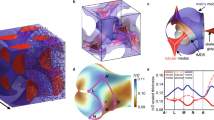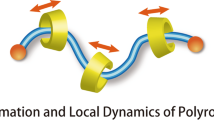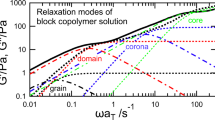Abstract
Closed-loop phase diagrams are known in systems with specific intermolecular interactions1,2,3,4. In weakly interacting systems, however, such behaviour has never been observed. Here, diblock copolymers formed from polystyrene covalently linked to poly (n-pentylmethacrylate), P(S-b-nPMA), which have only weak segmental interactions, are shown to exhibit a closed-loop phase behaviour over a narrow range of molecular weight. The endothermic transitions from the disordered to ordered and back to the disordered state, as a function of increasing temperature, are dominantly entropic in origin. The morphology and rheological properties of P(S-b-nPMA) undergo characteristic changes at the transitions. Whereas the disorder-to-order transition temperature increases with decreasing molecular weight, the order-to-disorder transition temperature decreases. At a limiting molecular weight, the closed-loop vanishes and no ordering occurs. These findings provide quantitative insight into an elusive transition in weakly interacting multicomponent systems.
This is a preview of subscription content, access via your institution
Access options
Subscribe to this journal
Receive 12 print issues and online access
$259.00 per year
only $21.58 per issue
Buy this article
- Purchase on Springer Link
- Instant access to full article PDF
Prices may be subject to local taxes which are calculated during checkout




Similar content being viewed by others
References
Malcolm, G.N. & Rowlinson, J.S. The thermodynamic properties of aqueous solutions of polyethylene glycol, polypropylene glycol and dioxane. Trans. Faraday Soc. 53, 921–931 (1957).
Davies, L.A., Jackson, G. & Rull, L.F. Simulation study of the link between molecular and re-entrant miscibility for a mixture of molecules with directional interactions. Phys. Rev. Lett. 82, 5285–5288 (1999).
Svoboda, P., Kressler, J., Chiba, T., Inoue, T. & Kammer, H.-W. Light-scattering and TEM analyses of virtual upper critical solution temperature behaviour in PCL/SAN blends. Macromolecules 27, 1154–1159 (1994).
Abbott, M.M. & Prausnitz, J.M. in Models for Thermodynamic and Phase Equilibria Calculations (ed. Sandler, S. I.) 1–86 (Marcel Dekker, New York, 1994).
Dudowicz, J. & Freed, K.F. Effect of monomer structure and compressibility on the properties of multicomponent polymer blends and solutions: 1. Lattice cluster theory of compressible systems. Macromolecules 24, 5076–5095 (1991).
Dudowicz, J. & Freed, K.F. Relation of effective interaction parameters for binary blends and diblock copolymers: Lattice cluster theory predictions and comparison with experiment. Macromolecules 26, 213–220 (1993).
Rosedale, J.H. & Bates, F.S. Rheology of ordered and disordered symmetric poly(ethylenepropylene)-poly(ethylethlene) diblock copolymers. Macromolecules 23, 2329–2338 (1990).
Bates, F.S., Rosedale, J.H., Bair, H.E. & Russell, T.P. Synthesis and characterization of a model saturated hydrocarbon diblock copolymer. Macromolecules 22, 2257–2564 (1989).
Paul, D.R. & Newman, S. in Polymer Blends 15–115 (Academic, New York, 1978).
Sanchez, I.C. in Polymer Compatibility and Incompatibility (ed. Solc, K.) 59–76 (MMI, New York, 1982).
Koningsveld, R., Stockmayer, W.H. & Nies, E. in Polymer Phase Diagrams 16–65 (Oxford Univ. Press, Oxford, 2001).
Bates, F.S. & Fredrickson, G.H. Block copolymer thermodynamics: theory and experiment. Annu. Rev. Phys. Chem. 41, 525–557 (1990).
Hashimoto, T. in Thermoplastic Elastomers (eds Legge, N. R., Holden, G. & Schroeder, H. E.) 349–383 (Hanser, New York, 1987).
Sanchez, I.C. & Lacombe, R.H. Statistical thermodynamics of polymer solutions. Macromolecules 11, 1145–1156 (1978).
Dudowicz, J. & Freed, K.F. Explanation for the unusual phase behaviour of polstyrene-b-poly(n-alkyl methacrylate) diblock copolymers: Specific interactions. Macromolecules 33, 5292–5299 (2000).
Hino, T. & Prausnitz, J.M. Lower and upper critical ordering temperatures in compressible diblock copolymer melts from a perturbed hard-sphere-chain equation of state. Macromolecules 31, 2636–2648 (1998).
Russell, T.P., Karis, T.E., Gallot, Y. & Mayes, A.M. A lower critical ordering transition in a diblock copolymer melt. Nature 368, 729–731 (1994).
Pollard, M., Russell, T.P., Ruzette, A.V.G., Mayes, A.M. & Gallot, Y. The effect of hydrostatic pressure on the lower critical ordering transition in diblock copolymers. Macromolecules 31, 6493–6498 (1998).
Ruzette, A.V.G. et al. Phase behaviour of diblock copolymers between styrene and n-alkyl methacrylates. Macromolecules 31, 8509–8516 (1998).
Ruzette, A.V.G. & Mayes, A.M. A simple free energy model for weakly interacting polymer blends. Macromolecules 34, 1894–1907 (2001).
Ruzette, A.V.G., Banerjee, P., Mayes, A.M. & Russell, T.P. A simple model for baroplastic behaviour in block copolymer melts. J. Chem. Phys. 114, 8205–8209 (2001).
Lee, C.H., Saito, H., Goizueta, G. & Inoue, T. An immiscibility loop in isotactic/partially hydrogenated oligo(styrene-co-indene) blend. Macromolecules 29, 4274–4277 (1996).
Leibler, L. Theory of microphase separation in block copolymers. Macromolecules 13, 1602–1617 (1980).
Sakamoto, N. & Hashimoto, T. Ordering dynamics of a symmetric polystyrene-block-polyisoprene; 2. Real-space analysis on the formation of lamellar microdomain. Macromolecules 31, 3815–3823 (1990).
Winey, K.I., Gobran, D.A., Xu, Z., Fetters, L.J. & Thomas. E.L. Compositional dependence of the order-disorder transition in diblock copolymers. Macromolecules 27, 2392–2397 (1994).
Ramachandrarao, V.S., Gupta R.R., Russell T.P. & Watkins J.J. Enhancement of diblock copolymer ordering kinetics by supercritical carbon dioxide annealing. Macromolecules 34, 7923–7925 (2001).
Acknowledgements
This work was supported by Teralevel Nanodevice (TND) projects (supported by the Korean Ministry of Science and Technology (MOST), the Applied Rheology Center governed by the Korean Organization of Science and Engineering Foundation (KOSEF)), and by the Department of Energy, the Office of Basic Energy Science and The National Science Foundation-supported Materials Research Science and Engineering Center, at the University of Massachusetts. Small-angle X-ray scattering measurements were performed at the Pohang Light Source, Korea, and were supported by MOST and POSCO.
Author information
Authors and Affiliations
Corresponding authors
Ethics declarations
Competing interests
The authors declare no competing financial interests.
Rights and permissions
About this article
Cite this article
Yeol Ryu, D., Jeong, U., Kon Kim, J. et al. Closed-loop phase behaviour in block copolymers. Nature Mater 1, 114–117 (2002). https://doi.org/10.1038/nmat724
Received:
Accepted:
Published:
Issue Date:
DOI: https://doi.org/10.1038/nmat724
This article is cited by
-
Morphological similarity of a tri-block copolymer processed at ambient and elevated temperatures
Korea-Australia Rheology Journal (2012)
-
Hartree analysis of χ for a pressure-responsive diblock copolymer: Temperature-pressure superposition
Macromolecular Research (2012)
-
Driving force for phase segregation in polymer mixtures
Macromolecular Research (2011)
-
Ultrahigh-density phase-change data storage without the use of heating
Nature Nanotechnology (2009)
-
Performing under pressure
Nature Nanotechnology (2009)



